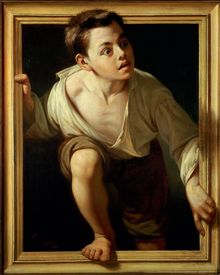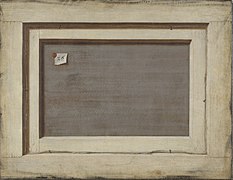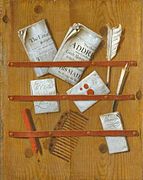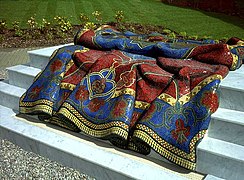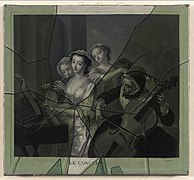Trompe-l'oeil
A trompe-l'œil [ tʀɔ̃pˈlœɪ̯ ] ( French: "deceive the eye", from tromper "deceive" and l'œil "the eye") is an illusionistic painting that simulates three-dimensionality by means of perspective representation .
Illusionistic wall and ceiling paintings create pseudo-architecture or expand the look of the architecture, for example with views of fantasy landscapes. By forced perspective spaces may appear larger or smaller.

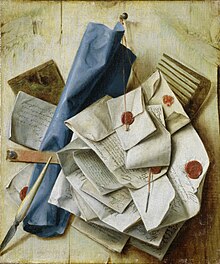
history
The oldest surviving examples are known from Pompeii . In the Middle Ages the technology was forgotten, in the Renaissance it was revived - starting with Italy - with the rediscovery of perspective . In profane painting, trompe-l'oeils were often used to aesthetically improve unclear room layouts or to create apparent views of Arcadian landscapes in living rooms .
The trompe l'œil style developed during the Renaissance. It goes hand in hand with the rediscovery of perspective and scientific advances in the field of optics . Niches with still lifes of flowers and fruits, shelves or cupboards with jewels , wooden walls with graphics and letters, or still lifes with hunted game and weapons were often used as motifs . Often a motif was represented by the same artist in several variants . The specialist in hunting motifs, Johannes Leemans, has at least three very similar still lifes with hunting implements including a central bird cage, surrounded by powder horns and weapons. One example is in the Kunstgewerbemuseum Berlin , the others were auctioned a few years ago by two international auction houses in Amsterdam.
Since the 15th century, attempts have been made to create views through alleged windows and domes indoors, using painted pseudo-architecture , in order to enlarge rooms to the glory of the client, but also to enjoy an enjoyable, humanistic landscape view. The templates for this were often the ancient villa letters from Pliny the Younger . Good examples of this are those by Andrea Mantegna for Luigi III. Gonzaga frescoes in the Camera degli Sposi ( Mantua , Castel San Giorgio ) created between 1465 and 1474 or the mural painting with fake window views by Paolo Veronese in the Venetian Villa Barbaro (Maser) around 1560 . Trompe-l'œil can also be found in the form of pseudo-architecture and Lüftlmalerei on facades.
In sacred painting, the heyday of the trompe-l'œil began with the Counter-Reformation . The vaulted ceilings of the mannerist churches of the Jesuits were painted with the Ascension of Jesus or Mary and thus opened to heaven. In the Rococo , these representations became more profane again and took on the classic-ancient themes, for example the depictions of gods.
In the 20th century, the Peintres de la Réalité and the Mouvement Trompe-l'œil / Réalité took up the trompe-l'œil techniques again. However, the group's painting did not see itself as a reappearance, but as a logical consequence of the development of a realism that took place in this century, which has taken the succession of surrealism to lead to the modern trompe-l'œil. German representatives of the Peintres de la Réalité were Liselotte Schramm-Heckmann and Werner Schramm .
Quodlibet
Often the terms trompe-l'œil and quodlibet are equated. Quodlibet actually refers to images that show an accumulation of disordered little things. Apart from that, quodlibets are often done in the form of graphic sheets, while trompe-l'œil are more often in the form of paintings. A well-known Quodlibet motif are deceptively real-looking documents, some with rolled-up corners. Quodlibets often also reproduce lifelike objects that are hanging on a wooden wall, for example.
Quodlibets were an integral part of the development of European still life painting, which emerged particularly in Holland and Flanders in the late 17th and 18th centuries. The style-defining works include Quodlibet by Cornelis Gijsbrechts (1675) and Quod Libet by Edward Collier (1701).
Usage today
Nowadays, the trompe-l'œil occurs as a - mostly private - room design in which wall painting has been used more intensively since around 1980. One of the pioneers of this was the English artist Graham Rust . The trompe-l'œil also comes to life in the design of public spaces in order to conceal architectural deficiencies in facades and to create a lively atmosphere in sterile urban empty spaces; Trompe-l'œil is described by the philosopher Robert Pfaller as " interpassive practice".
Trompe l'œil paintings and sculptures
Cornelis Gijsbrechts , back of a painting , 1670
Edward Collier , newspapers, letters and writing tools on a wooden board, around 1699
Landed “ Flying Carpet ”, mosaic sculpture on the stairs to the subway station at the American Museum of Natural History in New York
Marble bust with translucent veil, Bankfield Museum , 19th century
François-Xavier Vispré “painted over” an engraving by Philippe Mercier with a glass frame around 1760
literature
- Ursula Benad, Martin Benad: Illusion painting today. Deutsche Verlags-Anstalt, Stuttgart 2002, ISBN 3-421-03372-2 .
- Sören Fischer: The landscape as a framed view in the Venetian villas of the 16th century: Sustris, Padovano, Veronese, Palladio and the illusionistic landscape painting. Michael Imhof Verlag, Petersberg 2014, ISBN 978-3-86568-847-7 .
- Eckhard Hollmann, Jürgen Tesch: The art of eye deception . Prestel, Munich 2004, ISBN 978-3-7913-4709-7 .
- M. Monestier: Trompe-l'œil Contemporaine - Les maîtres du réalisme . Menges Publishing House, Paris. ISBN 2-85620-334-5 .
- Jean Monneret: Le Triomphe du Trompe-l'œil . Salon des Indépendents, Paris 1993. ISBN 2-85620-337-X .
- Miriam Milman: Le Trompe-l'œil . Albert Skira, Geneva 1986. ISBN 3-7796-5241-2 .
- Eugen von Philippovich: Curiosities / Antiques . Klinkhardt & Biermann, Braunschweig 1966.
- Graham Rust: Painted Ceiling . Constable & Robinson Ltd, ISBN 1-84119-310-0 .
- Graham Rust: The Painted House . Seven Dials, ISBN 1-84188-055-8 or ISBN 978-1-84188-055-6 .
- "Deceptively real. Illusion and Reality in Art ”- Catalog for the exhibition in the Bucerius Kunst Forum , Hamburg, 2010.
Web links
- Trompe l'œil Museum in France ( Memento of March 26, 2012 in the Internet Archive )
- International Trompe l'œil Festival Lodi, Italia (Italian)
- Trompe l'oeil side with examples (English)
- Trompe-l'œils at »ArtLex« (English) - Many picture examples from the 17th century until today
- Trompe-l'œil, facade painting, illusion painting: more than 11,000 photos from France (private site)
Individual evidence
- ↑ Henri Cadion, Claude Yvel: Peintres de la réalité du 20e siècle , Paris 1971
- ↑ The large art encyclopedia of PW Hartmann trompe l'oeil, French, "deceptive appearance", "optical illusion" .
- ↑ In 2016, the exhibitors in Kassel put a few real pieces of glass on the floor under the exhibited picture
